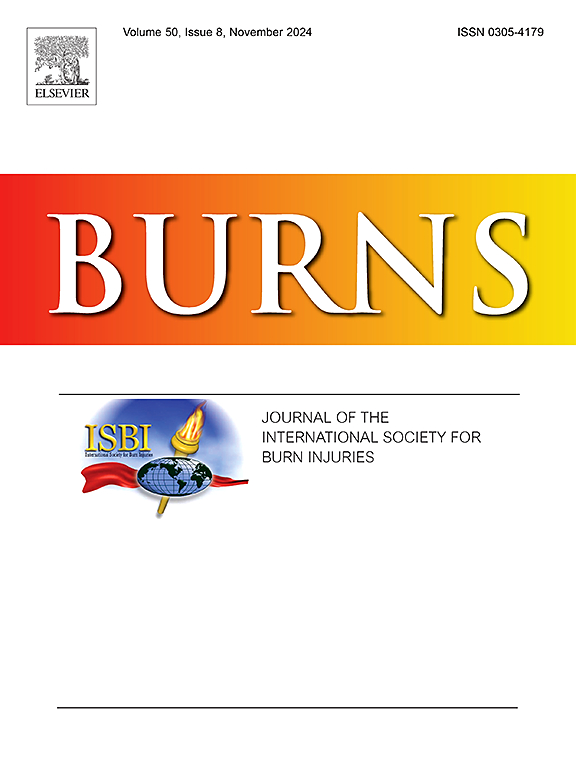激光微图案化真皮模板支持早期网状嵴形成和基底膜沉积与培养上皮自体移植物一起使用
IF 2.9
3区 医学
Q2 CRITICAL CARE MEDICINE
引用次数: 0
摘要
自体培养上皮移植(CEAs)治疗大面积烧伤的成功受到其脆弱性和与创面粘连性差的限制。真皮-表皮交界处的指间嵴是干细胞壁龛,对真皮-表皮粘附和皮肤内机械力的分布至关重要,但在cea治疗的烧伤创面中发育缓慢。采用猪烧伤-自体移植模型,研究同种异体真皮模板(DT)在改善CEA预后方面的效果。同种异体真皮模板植入成纤维细胞,并通过激光微图化使其具有真皮乳头样地形。自体CEA单独应用于全层创面或与扁平(CEA+扁平)或微图案(CEA+脊状)的dt一起应用。DT的使用改善了移植物的可处理性和伤口边缘的整合,并比单独使用cea快两周恢复表皮屏障功能。在CEA+脊状移植物中,移植后2周观察到角质细胞增殖和基底膜沉积增加。在整个研究过程中,只有CEA+脊状移植物在第2周时出现了网状嵴,CEA和CEA+扁平移植物的网状嵴出现的频率更低,也更浅。这些结果表明,激光微图DTs适合与cea共移植,并能显著改善移植物的粘附和发育。本文章由计算机程序翻译,如有差异,请以英文原文为准。
Laser micropatterned dermal templates support early rete ridge formation and basement membrane deposition when used with cultured epithelial autografts
The success of cultured epithelial autografts (CEAs) in treating large surface area burns is limited by their fragility and poor adhesion to the wound bed. Rete ridges, interdigitations at the dermal-epidermal junction, are stem cell niches critical to dermal-epidermal adhesion and distribution of mechanical forces within the skin, but are slow to develop in CEA-treated burn wounds. A porcine burn-excise-autograft model was used to investigate the efficacy of an allogeneic dermal template (DT), seeded with fibroblasts and laser micropatterned to have dermal papillae-like topography, in improving outcomes with CEA. Autologous CEAs were applied to full-thickness wounds alone or with DTs that were flat (CEA+Flat) or micropatterned (CEA+Ridged). The use of a DT improved graft handleability and integration at the wound margins, and restored epidermal barrier function two weeks faster than CEAs alone. In CEA+Ridged grafts, increases in keratinocyte proliferation and basement membrane deposition were observed at 2 weeks post-grafting. Rete ridges were only present in CEA+Ridged grafts at week 2, and developed less frequently and shallower in CEA and CEA+Flat grafts over the course of the study. These results suggest that laser micropatterned DTs are suitable for co-transplantation with CEAs and can significantly improve graft adhesion and development.
求助全文
通过发布文献求助,成功后即可免费获取论文全文。
去求助
来源期刊

Burns
医学-皮肤病学
CiteScore
4.50
自引率
18.50%
发文量
304
审稿时长
72 days
期刊介绍:
Burns aims to foster the exchange of information among all engaged in preventing and treating the effects of burns. The journal focuses on clinical, scientific and social aspects of these injuries and covers the prevention of the injury, the epidemiology of such injuries and all aspects of treatment including development of new techniques and technologies and verification of existing ones. Regular features include clinical and scientific papers, state of the art reviews and descriptions of burn-care in practice.
Topics covered by Burns include: the effects of smoke on man and animals, their tissues and cells; the responses to and treatment of patients and animals with chemical injuries to the skin; the biological and clinical effects of cold injuries; surgical techniques which are, or may be relevant to the treatment of burned patients during the acute or reconstructive phase following injury; well controlled laboratory studies of the effectiveness of anti-microbial agents on infection and new materials on scarring and healing; inflammatory responses to injury, effectiveness of related agents and other compounds used to modify the physiological and cellular responses to the injury; experimental studies of burns and the outcome of burn wound healing; regenerative medicine concerning the skin.
 求助内容:
求助内容: 应助结果提醒方式:
应助结果提醒方式:


